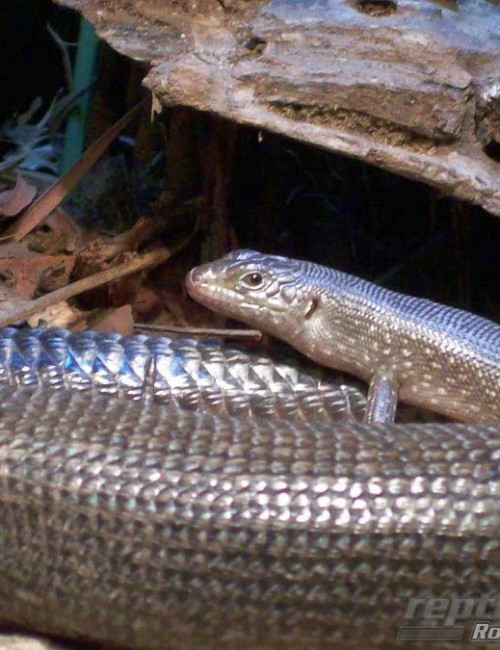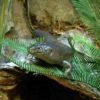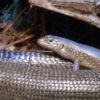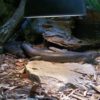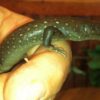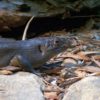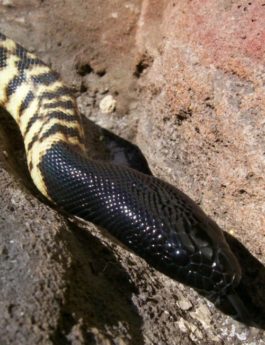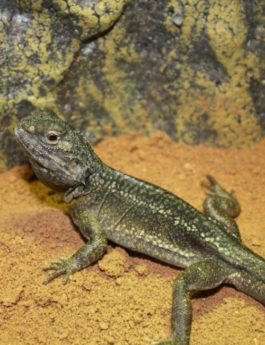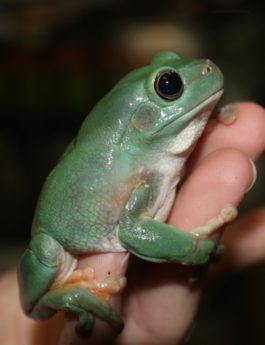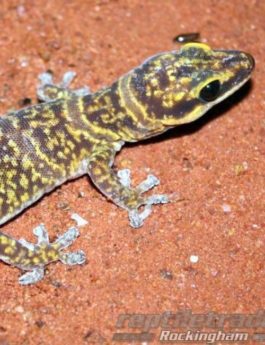Large variably marked Egernia; sole member of E. kingii group. Ground colour brown, greyish-brown, dark grey to almost black. Juveniles are sparsely to densely marked with prominent cream to yellow dashes and dots. Many populations retain this pattern to adulthood. Drab adults often bear fine indistinct longitudinal lines, formed by darkening on sides of dorsal and lateral scales. Indistinct vertical bars may be present on flanks. Ventral surfaces cream, pale yellow to grey, marked with darker reticulations or streaks, particularly beneath throat and tail. SVL 244mm.
In some areas rock crevices provide shelter On coast and islands, burrows of fairy penguins and shearwaters and dense low vegetation are often utilised. Humid to subhumid south-west WA mainland, from Hutt River in north to Duke of Orleans Bay in east. Most abundant on offshore islands, north to Houtman Abrolhos and east to Archipelago of the Recherche. Often associated with granite outcrops on mainland, and heathlands over sand or limestone on coast and islands.
Terrarium: King’s Skinks are a ground dwelling lizard, but are also great climbers, it is not essential to provide an enclosure with much height, however it is important to have plenty of ground space for them to comfortably move around their enclosure. A terrarium size of 90x45x45 (WxDxH) would be suitable to house 1 large adult, if you wish to house 2 or 3 King’s Skinks 120x60x60 would be better suited.
Lighting & Heating: King’s Skinks are primarily diurnal, therefore require high spectrum UVB lighting as well as an intense basking heat source. There are a number of ways to provide UVB, fluorescent 10.0 spectrum tubes or bulbs will provide UVB, a daylight basking heat globe will have to be used in conjunction. A mercury vapour globe will provide intense UVA & UVB light, mercury vapour globes are in our opinion superior to fluorescents as it is a longer lasting globe with more intense UVB output, however they cannot be used with a thermostat so work better with a larger enclosure that will easier maintain a thermal gradient. During the day, you want to achieve a basking ‘Hot Spot’ of 35°C and an air temperature ranging from 35°C in the hot end, and down to 20-25°C in the cool end. A heat rock or heat tile should be provided as tummy heat to help with digestion, this can also be used as a night time heat source. To monitor the temperatures inside the enclosure a thermometer should always be used.
Furnishings: A King’s Skinks enclosure should include a large log on the ground which provides a natural hiding spot and climbing enrichment. Two large, low hide rocks should be provided, one in the hot end and one in the cool end with the water bowl. Artificial foliage throughout the enclosure will allow the King’s Skink plenty of hiding spots and coverage. A pet bedding wood chips such as Chipsi or Critter Crumble can be used as a substrate, or red sand kept at the correct moisture would also be suitable and allow them somewhere to dig.
Food in captivity: King’s Skinks should be fed 2-3 times a week, varying their food will ensure a balanced diet. Their diet should include a variety of fruits, vegetables and insects such as wood roaches and crickets. Small mice, raw meat and canned pet food should be given in moderation, calcium and vitamin supplements should occasionally be added to their food.
The essentials:
- Terrarium of appropriate size
- High spectrum UVB lighting
- Daytime Basking globe
- Thermometer
- Ground heat
- Water bowl & Food bowl
- Substrate
- Large hide rocks
- Foliage for shelter
- Calcium and vitamin supplements
- Logs

